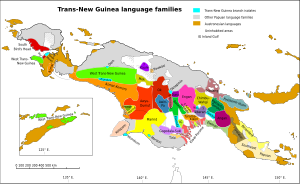Languages of Papua New Guinea
| Languages of Papua New Guinea | |
|---|---|
 |
|
| Official languages | Tok Pisin, English, Hiri Motu, Papua New Guinean Sign Language |
| Lingua franca | Tok Pisin |
The languages of Papua New Guinea today number over 850. These languages are spoken by the inhabited tribal groups of Papua New Guinea making it the most linguistically diverse place on earth. Its official languages are Tok Pisin, English, Hiri Motu and Papua New Guinean Sign Language. Tok Pisin, an English-based creole, is the most widely spoken, serving as the country's lingua franca. Papua New Guinean, Sign Language became the 4th official language in May 2015, as it is spoken by the deaf population all over the country and also Tuna.
Tok Pisin is a creole language spoken throughout Papua New Guinea. It is an official language of Papua New Guinea and the most widely used language in that country. In parts of Western, Gulf, Central, Oro Province and Milne Bay Provinces, however, the use of Tok Pisin has a shorter history, and is less universal, especially among older people.
Although English is an official language of Papua New Guinea, English is only spoken by 1–2% of the population.
Hiri Motu, also known as Police Motu, Pidgin Motu, or just Hiri, is a simplified version of Motu, of the Austronesian language family.
The longest-established languages of Papua New Guinea are known as the Papuan languages.
Outside of Papua New Guinea, Papuan languages are also spoken in Indonesia, East Timor, and the Solomon Islands.
People speaking languages belonging to the Austronesian family arrived in New Guinea approximately 3,500 years ago.
The Austronesian languages are widely spread across the globe, as far west as Malagasy in Madagascar, as far east as Rapa Nui on Easter Island, and as far as north as the Formosan languages of Taiwan. Austronesian has several primary branches, all but one of which are found exclusively on Taiwan.
...
Wikipedia
